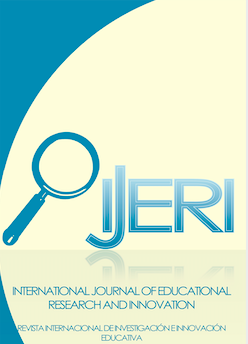The university internship as an orientation/training tool. The model of the Pedagogical Degree Courses of Sapienza (University of Rome)
DOI:
https://doi.org/10.24310/RevPracticumrep.v1i1.8258Keywords:
Internship model, circular and integrated model, critical reflection, interview, internship report.Abstract
The subject of this contribution is the presentation of the university curricular internship model adopted in the Degree Courses in Educational Sciences of the "Sapienza", University of Rome. The educational value of the internship activity in the development of professionalism lies not only in the possibility of promoting a generic link between training and work. It is also linked to the multiple possibilities to facilitate the professional choice of students, to be able to carry out a practical-professional experience and, again, to acquire social skills in the working "communities of practice". The university internship activity, in fact, if well designed and organized, allows young people to achieve a useful training to face the social and productive world allowing them to make informed professional choices. In addition, thanks to a well-planned internship, the organizations that host students (companies, public and private bodies) can have a direct knowledge of the specific professional profiles formed through university courses and the possible human resources to be employed. The pedagogical degree courses of "Sapienza" have created a circular and integrated model of internship or a model that allows you to plan a training course appropriate to the achievement of study and work objectives, taking into account the skills, knowledge and interests of students as well as the evolution of the labor market. To make the internship a truly training and orientation tool for work choices, a systematic activity of critical reflection on the entire activity by all the actors involved is fundamental: reflection to be conducted from the start-up phase to the final one. Central to this action is the monitoring of the activity, started since the academic year 2002-2003, in its different phases and by means of different detection tools now almost all digitized (from more structured tools such as questionnaires to semi-structured and open tools, such as the interview and the internship report).
Downloads
Metrics
Publication Facts
Reviewer profiles N/A
Author statements
Indexed in
-
—
- Academic society
- N/A
- Publisher
- Universidad de Málaga
References
Bereiter, C. (1980). Development in writing. In L.W. Gregg & E.R. Steinberg (Eds.), Cognitive Processes in Writing (pp. 73-93). Hillsdale: Erlbaum.
Bruner, J. (1996).The culture of education. Cambridge, Mass.: Harvard University Press.Demetrio, D. (1996). Raccontarsi. L’autobiografia come cura di sé. Milano: Raffaello Cortina.
Dewey, J.(1989). The School and Societyand The Child and the Curriculum.Chicago: University of Chicago Press.
Dewey J. (1904). The Relation of Theory to Practice in Education. In McMurry C. A. (ed.), The Third Yearbook of the National Society for the Scientific Study of Education. Chicago: The University of Chicago press, pp.9-29.
Dewey, J. (1929). The Source of a Science of Education. New York: Livering Publishing Corporation.
Dewey, J. (1938). Experience and education. Indianapolis: Kappa Delta Pi.
Frabboni, F & Guerra, L. & Lodini E., (1995), Il tirocinio nella formazione dell’operatore socioeducativo.Roma: Carocci.
Kaneklin, C. &. Scaratti G. (eds.) (1998), Formazione e narrazione. Costruzione di significato e processi di cambiamento personale e organizzativo. Milano: Raffaello Cortina.
Kolb, D. (1984). Experiential learning: experience as the source of learning and development, Englewood Ciffs, NJ: Prentice Hall.
Mezirow J. (1991). Transformative Dimensions of Adult Learning. San Francisco, CA: Jossey-Bass.
Mortari, L. (2003). Apprendere dall'esperienza. Il pensare riflessivo nella formazione. Roma: Carocci.
OECD (2015). Skills Outlook 2015.Youth, Skills and Employability, Published on May 27inhttp://www.oecd.org/education/oecd-skills-outlook-2015-9789264234178-en.htm
Salerni, A. (ed.).(2007).Apprendere tra università e lavoro. Un modello per la gestione del tirocinio universitario.Roma:, Homolegens.
Salerni, A. &Sposetti,P. (2010).La valutazione della produzione scritta universitaria: il caso delle relazioni di tirocinio. In E. Lugarini (Ed.), Valutare le competenze linguistiche. Atti del XV Convegno Nazionale Giscel (pp. 391-404). Milano: Franco Angeli.
Salerni, A., Sposetti, P. & Szpunar G. (2013).La narrazione scritta come elemento di valutazione del tirocinio universitario. Ricerche di pedagogia e didattica, 8, 9-26.
Salerni, A., Sposetti, P. & Szpunar G. (2014). Narrative writing and University Internship Program. Procedia -Social and Behavioral Sciences, 140, 133–137(doi: 10.1016 doi: 10.1016/j.sbspro.2014.04.398).
Salerni, A., Sanzo A. (ed.)(2013), Orientare al tirocinio e alle professioni. L’università incontra le aziende. Roma:Nuova Cultura.
Schön, D. A.(1987).Educating the Reflective Practitioner: Toward a New Design for Teaching and Learning in the Professions.San Francisco:Jossey-Bas.
Schön,D. A. (1983). The Reflective Practitioner: How Professionals Think in Action. New York: Basic Books.
Sposetti, P.(2011). Quante e quali scritture professionali in educazione. Italiano LinguaDue,3, 261-271.
Szpunar, G., Salerni, A., Sposetti, P., Renda E.(2015). Il tirocinio universitario come strumento di orientamento. L’esperienza dei Corsi di Laurea in Scienze dell’educazione della Sapienza di Roma. Formazione, Lavoro, Persona, 13, 146 –159.
Downloads
Published
How to Cite
Issue
Section
License
Acceptance of the work implies that the author grants Revista Prácticum the exclusive rights to reproduce, distribute and sell his or her work worldwide, both in digital and paper formats, CD-ROM, etc.
Likewise, the authors shall grant Revista Prácticum the rights of dissemination, public communication on the Internet and IT networks, data buses, as well as any other portals or electronic devices for online consultation of its contents and extracts, under the conditions of the portal, repositories or databases where the work is stored.
Revista Prácticum allows authors to publish and disseminate their articles and works on their personal websites, research teams, institutional repositories and scientific databases. All this in accordance with the Creative Commons 4.0 License










8.png)








